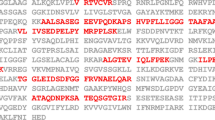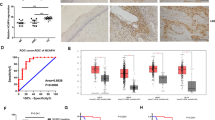Abstract
High-risk human papillomaviruses (HPVs) are etiologically linked to human cervical and oral cancers. The E6 and E7 oncoproteins encoded by HPV target host cell tumor suppressor proteins. E6 induces proteolysis of p53 through the ubiquitin-proteasome pathway. Recent studies showed that overexpression of E7 caused proteolytic degradation of the tumor suppressor Rb. However, unlike p53, Rb is not regulated by proteolysis in normal cells. In addition, it was unclear whether in its natural context E7 regulates Rb through the ubiquitin-proteasome pathway. Therefore, we sought to determine whether Rb is regulated by the ubiquitin-proteasome pathway in HPV-containing tumor cells. We carried out a detailed analysis in Caski cells, that are derived from HPV-containing cervical cancer tissues. Studies with various protease inhibitors revealed that Rb is regulated specifically by the ubiquitin-proteasome pathway in HPV-containing cervical tumor cells. Several inhibitors of the 26S proteasome significantly increased the level of Rb in the Caski cells. Rb controls cell growth by forming complexes with the E2F-family transcription factors. Surprisingly, in spite of a significant accumulation of the hypophosphorylated form of Rb, no Rb/E2F complex was detectable in the proteasome inhibitor treated cells. Further analysis revealed that there was an increased accumulation of the E7 oncoprotein. We showed that the proteasome inhibitors simultaneously blocked the proteolysis of E7 and Rb, suggesting that E7 is also regulated by the ubiquitin-dependent proteolysis in cervical cancer cells. Taken together, this study suggests that targeted inhibition of Rb proteolysis will be required for restoring Rb function in HPV-containing cervical cancer cells.
This is a preview of subscription content, access via your institution
Access options
Subscribe to this journal
Receive 50 print issues and online access
$259.00 per year
only $5.18 per issue
Buy this article
- Purchase on Springer Link
- Instant access to full article PDF
Prices may be subject to local taxes which are calculated during checkout







Similar content being viewed by others
References
Baumeister W, Walz J, Zuhl F, Seemuller E . 1998 Cell 92: 367–380
Berezutskaya E, Bagchi S . 1997a J. Biol. Chem. 272: 30135–30140
Berezutskaya E, Yu B, Morozov A, Raychaudhuri P, Bagchi S . 1997b Cell Growth Differ. 8: 1–10
Boyer SN, Wazer DE, Band V . 1996 Cancer. Res. 56: 4620–4624
Chellapan S, Kraus VB, Kroger B, Münger K, Howley PM, Phelps WC, Nevins JR . 1992 Proc. Natl. Acad. Sci. USA 89: 4549–4553
Chen P-L, Scully P, Shew J-Y, Wang JYJ, Lee W-H . 1989 Cell 58: 1193–1198
Cheng S, Schmidt-Grimminger D, Murant T, Broker T, Chow L . 1995 Genes Dev. 9: 2335–2349
Dubiel W, Ferrell K, Pratt G, Rechsteiner M . 1992 J. Biol. Chem. 267: 22699–22702
Fang S, Jensen JP, Ludwig RL, Vousden KH, Weissman AM . 2000 J. Biol. Chem. 275: 8945–8951
Galloway DA, McDougall JK . 1996 Semin. Cancer Biol. 7: 309–315
Halbert C, Demers G, Galloway D . 1992 J. Virol. 66: 2125–2134
Hecks DV, Yee CL, Howley PM, Münger K . 1992 Proc. Natl. Acad. Sci. USA 89: 4442–4446
Hietanen S, Lain S, Krausz E, Blattner C, Lane DP . 2000 Proc. Natl. Acad. Sci. USA 97: 8501–8505
Hochstrasser M . 1996 Annu. Rev. Genet. 30: 405
Honda R, Yasuda H . 1999 EMBO J. 18: 22–27
Howley PM . 1996 Fundamental Virology, Fields BN, Knipe DM and Howley PM (eds) Lippincott-Raven Publishers: Philadelphia pp. 947–978
Huibregtse JM, Scheffner M, Howley PM . 1991 EMBO J. 10: 4129–4135
Jones DL, Munger K . 1996 Semin. Cancer Biol. 7: 327–337
Jones DL, Munger K . 1997 J. Virol. 71: 2905–2912
Key LD, Adler-Storthz K, Mitchell MF, Clayman GL, Chen Z . 1999 Oral. Oncol. 35: 415–420
King RW, Deshaies RJ, Peters J, Kirschner MW . 1996 Science 274: 1652–1659
Laimins L . 1993 Inf. Agents Dis. 2: 74–86
Lipinski MM, Jacks T . 1999 Oncogene 7873–7882
Maki CG, Huibregtse JM, Howley PM . 1996 Cancer Research 56: 2649–2654
Musti AM, Treier M, Bohmann D . 1997 Science 275: 400–402
Murakami Y, Matsufuji S, Kameji T, Hayashi S, Igarashi K, Tamura T, Tanaka K, Ichihara A . 1992 Nature 360: 597–599
Nevins J-R . 1998 Cell Growth Differ. 9: 585–593
Niv A, Sion-Vardi N, Gatot A, Nash M, Fliss DM . 2000 J. Laryngol. Otol. 114: 41–46
Pagano M, Durst M, Joswig S, Draetta G, Jansen-Durr P . 1992 Oncogene 7: 1681–1686
Pan HC, Griep AE . 1994 Genes Dev. 8: 1285–1299
Pickart CM . 1997 FASEB J. 11: 1055–1066
Rechsteiner M, Hoffman L, Dubiel W . 1993 J. Biol. Chem. 268: 6065–6068
Raychaudhuri P, Bagchi S, Moran E, Devoto S, Krause V, Nevins JR . 1991 Genes Dev. 5: 1200–1211
Ruesch MN, Laimins LA . 1998 Virology 250: 19–29
Scheffner M, Wereness BA, Huibregtse JM, Levine AJ, Howley PM . 1990 Cell 63: 1129–1136
Scheffner M, Huibregtse JM, Vierstra RD, Howley PM . 1993 Cell 75: 495–505
Vousden KH . 1995 Semin. Cancer. Biol. 6: 109–116
Weinberg RA . 1995 Cell 81: 323–330
zur Hausen H . 1999 Semin Cancer Biol. 9: 405–411
Acknowledgements
We are grateful to Dirk Bohman of Heidelberg, Germany for generously providing the His6-tagged ubiquitin expression plasmid. We thank Ms Diane Rudall for editorial assistance in preparing this manuscript. Support for this research was provided by the grants DE12506 from the National Institute of Dental Research and CA76276 from the National Cancer Institute.
Author information
Authors and Affiliations
Corresponding author
Rights and permissions
About this article
Cite this article
Wang, J., Sampath, A., Raychaudhuri, P. et al. Both Rb and E7 are regulated by the ubiquitin proteasome pathway in HPV-containing cervical tumor cells. Oncogene 20, 4740–4749 (2001). https://doi.org/10.1038/sj.onc.1204655
Received:
Revised:
Accepted:
Published:
Issue Date:
DOI: https://doi.org/10.1038/sj.onc.1204655
Keywords
This article is cited by
-
The ubiquitin specific protease 7 stabilizes HPV16E7 to promote HPV-mediated carcinogenesis
Cellular and Molecular Life Sciences (2023)
-
Human papillomavirus E7 induces p63 expression to modulate DNA damage response
Cell Death & Disease (2018)
-
Regulating the human HECT E3 ligases
Cellular and Molecular Life Sciences (2018)
-
Simvastatin and Atorvastatin inhibit DNA replication licensing factor MCM7 and effectively suppress RB-deficient tumors growth
Cell Death & Disease (2017)
-
Marine Streptomyces sp. derived antimycin analogues suppress HeLa cells via depletion HPV E6/E7 mediated by ROS-dependent ubiquitin–proteasome system
Scientific Reports (2017)



